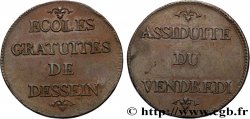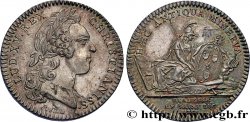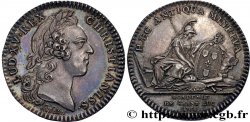E-auction 357-270761 - fjt_575743 - ACADEMIES AND LEARNED SOCIETIES Société des inventions et découvertes 1791
You must signin and be an approved bidder to bid, LOGIN TO BID. Accounts are subject to approval and the approval process takes place within 48 hours. Do not wait until the day a sale closes to register. Clicking on « bid » constitutes acceptance of the terms of use of cgb.fr private e-auctions.
Bids must be placed in whole Euro amounts only. The sale will start closing at the time stated on the item description; any bids received at the site after the closing time will not be executed. Transmission times may vary and bids could be rejected if you wait until the last second. For further information ckeck the E-auctions F.A.Q.
NO BUYER'S FEE.
NO BUYER'S FEE.
| Estimate : | 50 € |
| Price : | 34 € |
| Maximum bid : | 51 € |
| End of the sale : | 17 February 2020 18:33:00 |
| bidders : | 5 bidders |
Type : Société des inventions et découvertes
Date: 1791
Metal : red copper
Diameter : 27 mm
Orientation dies : 6 h.
Weight : 7,16 g.
Edge : cannelée
Obverse
Obverse legend : MENTE MANU QUE.
Obverse description : Buste de la France casquée à gauche, sous les traits de Minerve. Signé Dupré.
Obverse translation : Par son esprit et par sa main.
Reverse
Reverse legend : SOCIETE DES INVENTIONS ET DECOUVERTES ; À L'EXERGUE : LE 7 JANVIER 1791.
Reverse description : Inscription en six lignes dans le champ.
Commentary
Cette société fut formée en 1791 pour encourager les recherches et découvertes dans toutes les branches de l'industrie.
De toute évidence elle fut très importante et après l’introduction ci-dessous
Avec la loi du 21 août 1790 autorisant les sociétés libres, certains « artistes-inventeurs » se regroupent au sein de la Société des inventions et découvertes dès l’été 1790 pour obtenir des mesures garantissant leur propriété sur leurs inventions.
La documentation existante sur la Société des inventions et découvertes, même si elle est lacunaire, permet de la saisir à quatre moments clés de son existence : en 1791, lors du vote des lois protectrices de l’invention, puis en 1793, lorsqu’elle se met au service de la Patrie en danger, en l’an VI [1798] avec un projet de règlement particulièrement novateur, et enfin à son déclin, en 1810-1811. Elle permet aussi de mettre en évidence certains points forts de la Société ; elle montre notamment que, par la capacité de ses membres à s’organiser, elle a joué un rôle de premier plan dans l’adoption, en France, de la législation sur les brevets d’invention et, au-delà, dans l’émergence dans le débat public des gens de métier par une autre voie que la voie politique bien connue des sociétés populaires, et leur volonté de prendre en mains collectivement leurs propres intérêts.
On peut aller voir l’étude de Christiane Demeulenaere-Douyère à http://dht.revues.org/483.
De toute évidence elle fut très importante et après l’introduction ci-dessous
Avec la loi du 21 août 1790 autorisant les sociétés libres, certains « artistes-inventeurs » se regroupent au sein de la Société des inventions et découvertes dès l’été 1790 pour obtenir des mesures garantissant leur propriété sur leurs inventions.
La documentation existante sur la Société des inventions et découvertes, même si elle est lacunaire, permet de la saisir à quatre moments clés de son existence : en 1791, lors du vote des lois protectrices de l’invention, puis en 1793, lorsqu’elle se met au service de la Patrie en danger, en l’an VI [1798] avec un projet de règlement particulièrement novateur, et enfin à son déclin, en 1810-1811. Elle permet aussi de mettre en évidence certains points forts de la Société ; elle montre notamment que, par la capacité de ses membres à s’organiser, elle a joué un rôle de premier plan dans l’adoption, en France, de la législation sur les brevets d’invention et, au-delà, dans l’émergence dans le débat public des gens de métier par une autre voie que la voie politique bien connue des sociétés populaires, et leur volonté de prendre en mains collectivement leurs propres intérêts.
On peut aller voir l’étude de Christiane Demeulenaere-Douyère à http://dht.revues.org/483.








 Report a mistake
Report a mistake Print the page
Print the page Share my selection
Share my selection Ask a question
Ask a question Consign / sell
Consign / sell
 Full data
Full data











